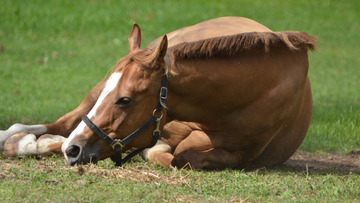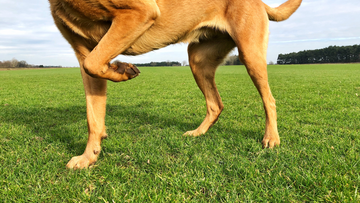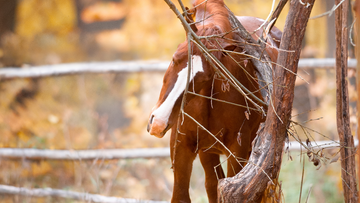A horse’s nature and their environment can contribute to scrapes, bruises, cuts, punctures, and all sorts of different trauma to the legs. Usually, these are not serious, and the swelling goes away easily. However, horses are also susceptible to a more challenging type of limb swelling called cellulitis. Cellulitis is a bacterial infection of the soft connective tissue under the skin. It can occur anywhere on the body, but it is more common on the hind legs. The disease starts with a wound or scratch that allows bacteria to breach the protective layers of the skin and then spreads to deeper tissues.

The initial cause of cellulitis cannot always be found, but certain environmental conditions—including prolonged exposure to deep mud or sand can promote cellulitis growth as well. Also, a horse with cracked heels, or dew poisoning might also pick up bacteria. There are many different species of bacteria that can lead to the infection, but Staphylococcus is the most common.
Common Signs:
- Swelling
- Hot to touch
- Pain
- Fever
- Depression
Although some of these signs are distinctive, cellulitis is not necessarily easy to diagnose because many other problems—fracture, bruising, joint infection, to name a few—can cause sudden, painful swelling in a leg.
Preventative methods:
- Maintaining regular exercise
- Keeping legs dry and clean
- Avoid water, mud, or sand
- Clean and disinfect even the smallest wounds
- Sterilize grooming equipment
Early treatment is critical in cases of cellulitis. There are two main focuses in treating cellulitis. The first is eliminating the infection in the leg and the second is reducing the inflammation. The primary treatment is antibiotics as well as non-steroidal anti-inflammatory medications to address pain and inflammation.
As a horse’s condition progresses, walking can help improve his circulation and pull fluid out of the leg. Hydrotherapy with cold hosing, bandaging, and hand-walking or lunging are often key components of treatment and are used in combination to help reduce the swelling of the limb. Most horses who develop cellulitis recover completely, especially if treatment begins promptly and they start to respond within the first 24 to 48 hours. Always contact your veterinarian for a treatment plan.
Benefab can also lend a helping hand with our Antimicrobial Therapeutic VersiWraps. Our VersiWraps are made from premium, antimicrobial therapeutic fabric that reduces growth of odor-causing bacteria while enhancing overall circulation and decreasing inflammation. The cushioning of the wraps will provide comfort to your horse while the ribbing feature allows for ample breath-ability and flexibility. Our VersiWraps are the perfect equine accessory that can provide protection to your horse’s legs and their versatility allows them to be used as a standing bandage or a polo liner.






















